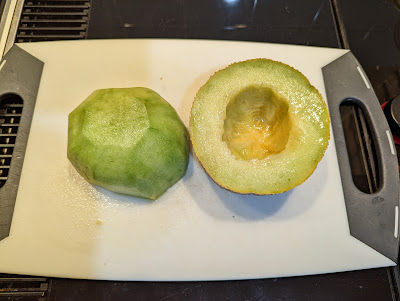Here's another Harvest Monday update from Eight Gate Farm. Monday and Tuesday were both days of solid rain. Welcome, but not enough to get us out of the drought conditions. It was Wednesday before I ventured out to the gardens to harvest. Predictably, a lot of the smaller-fruit tomatoes were splitting; even Juliet, which is known for its crack resistance.
For "first harvests," ripe "Hot Lemon" peppers made their appearance. This variety is another that is too hot to eat outright, but makes an excellent, floral hot sauce that's colorful too. They're super attractive, I think.
 |
| 'Hot Lemon' peppers |
"Rocky Ford" is a green-fleshed cantaloupe. The seeds were a free sample in one of my orders this year. Cutting it open, I was struck by its intense candy-like aroma. It is juicy and super-tasty.
 |
| 'Rocky Ford' cantaloupe |
This is the first year I've had what I would call success in growing celery. Compared to supermarket celery, besides being smaller, it is all green, fibrous, and strong-flavored, with no bitterness. I think it would make an excellent cream soup.
 |
| 'Ventura' (OP) celery |
Now on to the "general harvests." Here is Wednesday's tomato picking.
 |
| Wednesday tomato harvest |
Wednesday's hot pepper harvest.
 |
| Wednesday hot pepper harvest |
And Wednesday's "everything else" harvest
 |
| The rest of Wednesday's harvests |
Friday was similar in a lot of ways.
 |
| Friday tomato harvest |
 |
| Friday hot pepper harvest |
 |
| Friday "everything else" harvest |
The Kitchen Goddess continues to do almost daily picking from the raspberry vines.
 |
| Sample raspberry picking |
For "preserving the harvests," besides a lot of processing vegetables for the freezer, on Saturday we made several varieties of hot sauce. I made four bottles each of 100% cayenne and 100% habanero (atomic!). I used the simple, non-fermented way of boiling the chopped peppers in vinegar with a little salt, blending them, and straining into bottles. TKG took what I had that wouldn't fit into more bottles, and blended with the fermented Sugar Rush Cream pepper mash that was ready to go. She netted six bottles. After this, I had to order yet more bottles, as there are a lot more peppers on the way.
 |
| Cayenne, habanero, and mixed sauces |
I'm really wrestling with the concept of scaling back production of many things next year. I want to make sure I have enough of the things we really use, and cut back on the non-essentials. We're giving away so much produce, and that's a feel-good thing, but also kind of strange. I also hate to see bare beds. This has been a super-productive year, but there are no guarantees about next year's conditions. I haven't made any decisions yet, just thinking.
That's all for this week. Thanks for reading, and thanks as always to Dave at HappyAcres.blog for hosting Harvest Monday!
Happy you were successful with growing celery. It is a favorite cool season crop for me. I find the flavor becomes stronger with warm weather. 'Ventura' variety harkens to the city in California that, with their cool weather was a celery growing center for decades. Now, houses cover those former fields with feet of rich topsoil. Celery is a heavy feeder and needs lots of water. You might enjoy this post from my blog.
ReplyDeletehttps://www.ediblegardens52.com/ediblegardens52/2021/3/2/celery-in-the-fog-belt?rq=ventura
Thanks Sue. Growing up in Santa Barbara, I well remember how rural Ventura used to be. And thanks for the celery link...I went down a complete rabbit hole with it.
DeleteThat is a lot of good-looking hot sauce! The habanero would be too much for me, since cayenne is about as hot as I line to go. I am just now starting to make some sauce here. I'm using the relatively tame jalapenos at the moment.
ReplyDeleteLike you, I am trying to figure out how to scale back the garden a bit more. We're not giving much away, but I don't want to feel like I am a slave to the garden either. One thing I do with idled beds is plant something low-yielding like blackeyed peas or shell beans. And then there's always buckwheat, which is a feast for the bees and pollinators!
Thanks Dave. I've planted buckwheat as a cover crop in the past, and enjoyed watching the abundant pollinators so much I couldn't cut it down before it set seed...all over the place.
Delete